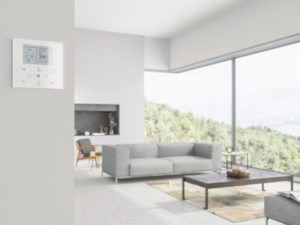This audio was created using Microsoft Azure Speech Services
Smart home technology makes it possible.
It seems everyone and everything is “going electric” these days, from the way we fuel our cars and cook our food to how we heat our homes. Yet how does this square with longstanding directives to reduce our energy consumption? (If you’re scratching your head, you’re not alone.)
The good news is, you can go electric and reduce your energy consumption at the same time. The better news is, once your home is fully electric, reducing your energy consumption will be easier than you may think, thanks to digitization and IoT. And the best news is, in addition to saving energy and money, you’ll be doing your part to help save the planet, as well.
A global consumer study conducted for Schneider Electric shows that 75% of those surveyed are concerned about climate change, with more than half (55%) believing it’s important that their homes become net zero.1 That’s significant because homes are where you can have the greatest impact. Did you know that residences today already represent 20% of carbon dioxide emissions and are predicted to become the single largest consumer of electricity by 2050?2,3
Yes, your home alone is like a drop in the ocean. But when you combine all of our homes, they represent one-fifth of greenhouse gas emissions worldwide. So really, all drops do matter.
You can help reduce those emissions as well as your energy consumption by leveraging the combination of electricity and digitization that signals the arrival of the Electricity 4.0 era.

Embracing Electricity 4.0
As “Electricity 4.0” implies, we are at the start of the fourth electricity-driven revolution of the last 250 years:
- Electricity 1.0 brought electrification into homes
- Electricity 2.0 saw the emergence of centralized power plants
- Electricity 3.0 hailed the birth of green power and decentralization
- And now, Electricity 4.0 puts a zero-carbon, zero-waste, and zero-emissions future within our grasp
At the heart of Electricity 4.0 are electrification and digitization, the keys to doing more with less energy and fewer resources. Why electrification? Because electricity is the most efficient form of energy, the best vector of decarbonization, and the easiest power to generate locally. It’s also cleaner than burning fossil fuels, hence its growing preference for heating, cooking, and transportation.
And why digitization? Because through digital technologies, massive amounts of invisible energy become visible. This allows you to actively manage your energy use, minimize waste, and improve the efficiency of your home. In fact, these smart technologies can even automate energy management for you. So when you combine this smart technology, or digitization, with a zero-carbon energy supply provided by renewables like solar, you make decarbonization, energy independence, efficiency, and sustainability possible.
The most significant difference between Electricity 4.0 and previous electricity-driven revolutions is that it transforms the way energy is delivered from a one-way push by a utility to a two-way flow between multiple participants. Now consumers and businesses generate electricity, too, and become actively engaged in the production, consumption, and management of their energy.
Make your home smart and sustainable
Like most homeowners, you have likely taken steps to make your home more energy efficient at the device level, i.e., appliances, lighting, air conditioners, etc. The next step is to graduate to a home energy ecosystem where, instead of working in silos, your devices work in concert with your home power sources and share data to advance efficiency and sustainability. Think of it as having an energy operating system – OS for short – for your entire residence.
So what does this next-level smart and sustainable home look like? There are solar panels on the roof, battery storage capabilities in the utility room, an electric vehicle and EV charger in the garage, and IoT-enabled devices throughout. And they’re all connected to a smart hub that allows you to
manage your energy-consuming and energy-producing devices right from your phone. The smart-home energy OS attacks energy waste with machine intelligence to make smarter consumption decisions automatically. The system also provides primary and backup electricity generation to provide always-on power, minimize peak electricity charges, and reduce overall energy costs by integrating renewables.
That’s the home of the future in a nutshell and, best of all, the future is now.
Homes of the future, here today
Energy accounts for 74% of U.S. greenhouse emissions, including 92% of carbon emissions, according to the U.S. Energy Information Administration.4 We now have the tools and technology to address those numbers through electrification and digitization. Electricity makes energy green. And digitization unlocks decarbonization.
While many providers are looking to address one part of the smart and sustainable home challenge, Schneider Electric is committed to solving the whole thing. The company has intentionally built a portfolio of technology, talent, and partnerships to make the transition to an electrified and digitized home easier, enabling homeowners to do their part on our collective journey to a net zero world.
Product solutions include switches, sockets, and controls; electrical panels and protection; electric vehicle charging; and smart hubs and devices. And through Schneider Electric partnerships with installers, electricians, and homebuilders, these solutions can be incorporated into new or existing homes
to make living safe and secure, more comfortable and convenient, and energy-efficient and sustainable.
Bottom line? Now you can have the best of both worlds: going electric and cutting your energy consumption at the same time.
Learn more about homes of the future from Schneider Electric.
- The representative consumer survey was conducted by Opinium on behalf of Schneider Electric amongst 8,019 respondents across 6 markets (Australia, France, Spain, Sweden, UK and USA) in July 2021. All surveys were conducted in respondents’ native language, with translations provided by a professional translation company.
- https://www.un.org/en/actnow/facts-and-figures
- https://www.eia.gov/outlooks/ieo/pdf/ieo_infographics_3.pdf
- https://www.eia.gov/energyexplained/energy-and-the-environment/where-greenhouse-gases-come-from.php



